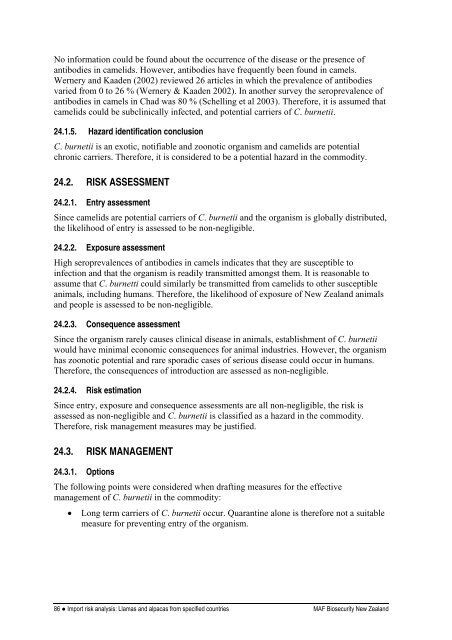Import risk analysis: Llamas (Lama glama) and alpacas (Vicugna ...
Import risk analysis: Llamas (Lama glama) and alpacas (Vicugna ...
Import risk analysis: Llamas (Lama glama) and alpacas (Vicugna ...
You also want an ePaper? Increase the reach of your titles
YUMPU automatically turns print PDFs into web optimized ePapers that Google loves.
No information could be found about the occurrence of the disease or the presence of<br />
antibodies in camelids. However, antibodies have frequently been found in camels.<br />
Wernery <strong>and</strong> Kaaden (2002) reviewed 26 articles in which the prevalence of antibodies<br />
varied from 0 to 26 % (Wernery & Kaaden 2002). In another survey the seroprevalence of<br />
antibodies in camels in Chad was 80 % (Schelling et al 2003). Therefore, it is assumed that<br />
camelids could be subclinically infected, <strong>and</strong> potential carriers of C. burnetii.<br />
24.1.5. Hazard identification conclusion<br />
C. burnetii is an exotic, notifiable <strong>and</strong> zoonotic organism <strong>and</strong> camelids are potential<br />
chronic carriers. Therefore, it is considered to be a potential hazard in the commodity.<br />
24.2. RISK ASSESSMENT<br />
24.2.1. Entry assessment<br />
Since camelids are potential carriers of C. burnetii <strong>and</strong> the organism is globally distributed,<br />
the likelihood of entry is assessed to be non-negligible.<br />
24.2.2. Exposure assessment<br />
High seroprevalences of antibodies in camels indicates that they are susceptible to<br />
infection <strong>and</strong> that the organism is readily transmitted amongst them. It is reasonable to<br />
assume that C. burnetti could similarly be transmitted from camelids to other susceptible<br />
animals, including humans. Therefore, the likelihood of exposure of New Zeal<strong>and</strong> animals<br />
<strong>and</strong> people is assessed to be non-negligible.<br />
24.2.3. Consequence assessment<br />
Since the organism rarely causes clinical disease in animals, establishment of C. burnetii<br />
would have minimal economic consequences for animal industries. However, the organism<br />
has zoonotic potential <strong>and</strong> rare sporadic cases of serious disease could occur in humans.<br />
Therefore, the consequences of introduction are assessed as non-negligible.<br />
24.2.4. Risk estimation<br />
Since entry, exposure <strong>and</strong> consequence assessments are all non-negligible, the <strong>risk</strong> is<br />
assessed as non-negligible <strong>and</strong> C. burnetii is classified as a hazard in the commodity.<br />
Therefore, <strong>risk</strong> management measures may be justified.<br />
24.3. RISK MANAGEMENT<br />
24.3.1. Options<br />
The following points were considered when drafting measures for the effective<br />
management of C. burnetii in the commodity:<br />
� Long term carriers of C. burnetii occur. Quarantine alone is therefore not a suitable<br />
measure for preventing entry of the organism.<br />
86 ● <strong>Import</strong> <strong>risk</strong> <strong>analysis</strong>: <strong>Llamas</strong> <strong>and</strong> <strong>alpacas</strong> from specified countries MAF Biosecurity New Zeal<strong>and</strong>

















